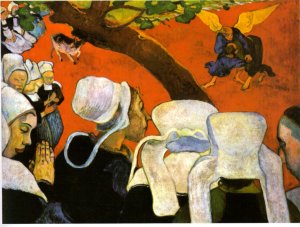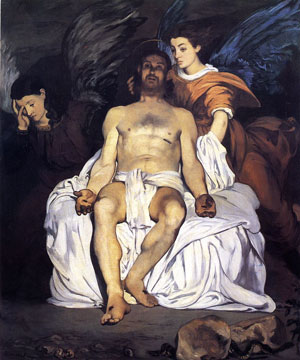During our research we have decided to concentrate on art pieces. An important terminus by defining what comes into the range of art and what doesn’t has been aesthetic intentionality. Let’s assume that we reduce our research on artifacts, on aesthetic phenomenons that are in the world with the intention of making them as they are. The best example to illustrate this differentiation is of course the couple nature/culture or here, the differentiation between the (visual) perception of a natural environment and the (visual) perception of a piece of art. The transcendentalist would argue that there is no essential difference between both. God is the maker of all things as each artist is the maker of his works of art. We are not going to argue on that here. Nature is beautiful. I understand the notion of the picturesque but also the one of landscape (speaking of landscape is always speaking as an aesthete) in this affirmation: “It seems to be made for me to look at it, for me to contemplate.” The thing is that it is certainly not made solely for that purpose and most probably it is not made for that purpose. Nature is ruled by laws of functionality in the first place. Its beauty is a result of this functionality. Let’s accept that here. There is no aesthetic plan behind. We decide thus to be aesthetical functionalists within this project. Our analyze and our research would narrow on aesthetical phenomenons where the primary function is precisely to be apprehended as such.
But we are not out of the problems here. Reading Rancière has taught us that in aesthetics there are no boundaries between disciplines. Rancière positions himself as the anti-essentialist breaking all our certainties about the specificity of one art discipline towards another by trying to define art disciplines outside of the range of their technical realization. Film, he states, existed before the actual invention of the first camera. he doesn’t take here into account natural phenomenons like the camera obscura but narrative techniques that lead to a cinematic experience. Flaubert, he states, was a filmmaker. On the other hand he discusses a picture taken by an SS-officer in Auschwitz and finds its direct lineage in a painting of Rembrandt. Flaubert’s intention was not to make cinema and the intention of the nazi was certainly not to position himself in art history. Rancière, like we two do, positions himself as what he is: a reader, a spectator telling about his experiences with art and analyzing them. Making links. Why exactly would we make a differentiation between being spectators of art, spectators of picturesque landscape or spectators of ourselves?
I relate the best to pieces of art that have freed themselves from their authors. I like the idea of art being an activity where someone abandons something to history. He leaves his work as a historical artifact of its time. His authorship becomes irrelevant at the moment when he offers his work to a public. The art piece is in between it pairs. Experiencing some representatives of Minimal Art in a Museum in Geneva has been the first impulse, the first permission, as Morton Feldman would say, for becoming myself an artist. But experiencing art is also entering in relation with the author of that work. Someone has had a vision, someone has worked and re-worked a certain material for me to see it how it is. Being myself an artist I need to imagine a fellow artist behind a work and even more important, I need to think a work of art in the continuity of the carrier of the artist. I need to think it in evolution. Maybe that’s the true difference. Every art piece has an author and places itself therefore in history. The cycles of nature are very different. But then again we could argue on the definition of nature. What is that actually? And how often were we placed into an environment that we could call “natural”? Here again a huge discussion opens. Does this mean an environment not touched by man? An environment preserved by man? When do we start to talk about nature? Are the numerous national parks on this planet the last remnants of nature? Are the parks of our cities nature? The plants growing in our houses? The hair growing on our heads? I am not sure that I want to enter into this question of ethics. Let’s stay in the aesthetics.
We have talked about transgressive phenomenons in art. To be short let’s say here that they are moments and let’s say here that they are moments where the distance between art piece and perceiver becomes blurry. Moments (and we are back to the idea of intentionality) where the art piece manages to suck the perceiver inside of its reality. This notion is rather vague and needs to be defined more precisely. Is the fact of being moved by something (and let’s assume that we are talking about an art piece here) not already a transgession of my position towards this something? And if we even go further: is the fact of something catching our attention not already a transgression? A transgression of what? Of our freedom to pay attention to things and not to others? It seems to me that we enter here the beautiful world of media criticism. Our notion of transgression, for sure, needs to be clarified.
The notion of transgression is a very powerful one when we talk about art. It has been used a lot since the late 80’s to talk about art that intentionnaly is meant to shock the audience (G. Bataille, histoire de l’oeil should come on our list). So we are primarily talking here of transgression of moral rules valid in society. The transgression we are talking about is an aesthetic one. It presupposes the autonomy of the viewer towards the art piece and the autonomy of the art piece towards the viewer. This is very questionable whilst desirable from a political point of view. Our contemporary visual culture is constantly working on transcending the visible to all the senses. Installation art is art where you are in the art work, going to the cinema nowadays with the possibility of the Dolby Surround is an experience of total submersion into an universe. But is this different than the horrific experience made by the first viewers of the movie L’arrivée du train en gare de la Ciotat from les frêres Lumière? Is the progress of the technique not just accompanying the progress of our habits as viewers? It is a common sense to say that the visual is ruling our contemporary culture. Didi-Huberman goes back as far as to one of the first theologists, Retullus, in order to reverse the common sense and speak of “la haine du visible”, the hatred of the visible. We constantly want to go beyond the visual, to transgress its possibilities. But is this such a strange thing?
I’ve spent a lot of time in forest those days and in the past few years. I enjoy being there in the company of trees. Walking a forest is each time a little adventure to me. You see things from a different point of view, apprehend time in an other way, get in contact with the wild, sometimes you can get lost in a forest and then you can only look for an issue with the hope that you won’t walk in circles. I mostly walk in forests with a photo camera at reach. When I see something that appears picturesque to me I start to shoot. How could I state that this picturesque impression is purely visual? This would be omitting a lot of parameters like my capacity of attention at that moment, boredom, exhaustion after a long walk, the loneliness of my thoughts. I like the idea expressed by Werner Herzog in Wim Wenders’ documentary Tokyo Ga: “Sometimes making a picture is the reward of a lot of efforts. It has taken a whole day to climb that mountain, a lot of sweat. And now finally you are on the top and you are ready to make that picture. Pictures have their price!” I write here what I remember of this interview taken ironically in a elevator bringing Herzog and Wenders high above the skyline of the city. From that point of view I understand Rancière (again him) stating that images are not an exclusivity of the visible.


 – When van Mechelen quotes a general statement about performance art being ephemeral and not-reducible to any documentation we can also get back to Jacques Rancière and le partage du sensible. There he breaks all the illusions about the autonomy of the work of art, all the illusions also of the autonomy and “purity” of the idea of medium.
– When van Mechelen quotes a general statement about performance art being ephemeral and not-reducible to any documentation we can also get back to Jacques Rancière and le partage du sensible. There he breaks all the illusions about the autonomy of the work of art, all the illusions also of the autonomy and “purity” of the idea of medium.
